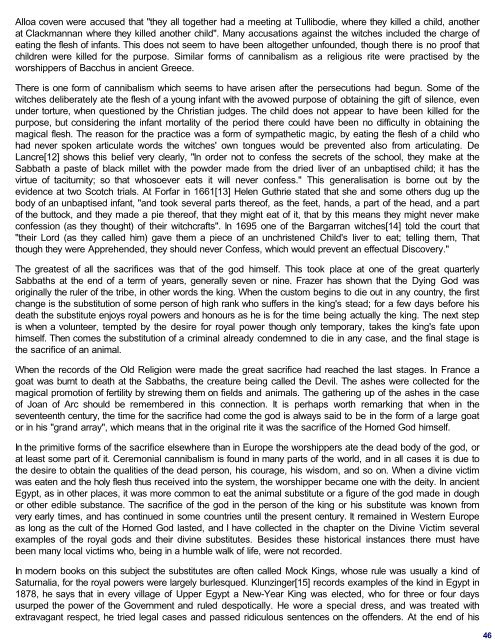THE GOD OF THE WITCHES - World eBook Library - World Public ...
THE GOD OF THE WITCHES - World eBook Library - World Public ...
THE GOD OF THE WITCHES - World eBook Library - World Public ...
Create successful ePaper yourself
Turn your PDF publications into a flip-book with our unique Google optimized e-Paper software.
Alloa coven were accused that "they all together had a meeting at Tullibodie, where they killed a child, another<br />
at Clackmannan where they killed another child". Many accusations against the witches included the charge of<br />
eating the flesh of infants. This does not seem to have been altogether unfounded, though there is no proof that<br />
children were killed for the purpose. Similar forms of cannibalism as a religious rite were practised by the<br />
worshippers of Bacchus in ancient Greece.<br />
There is one form of cannibalism which seems to have arisen after the persecutions had begun. Some of the<br />
witches deliberately ate the flesh of a young infant with the avowed purpose of obtaining the gift of silence, even<br />
under torture, when questioned by the Christian judges. The child does not appear to have been killed for the<br />
purpose, but considering the infant mortality of the period there could have been no difficulty in obtaining the<br />
magical flesh. The reason for the practice was a form of sympathetic magic, by eating the flesh of a child who<br />
had never spoken articulate words the witches' own tongues would be prevented also from articulating. De<br />
Lancre[12] shows this belief very clearly, "In order not to confess the secrets of the school, they make at the<br />
Sabbath a paste of black millet with the powder made from the dried liver of an unbaptised child; it has the<br />
virtue of taciturnity; so that whosoever eats it will never confess." This generalisation is borne out by the<br />
evidence at two Scotch trials. At Forfar in 1661[13] Helen Guthrie stated that she and some others dug up the<br />
body of an unbaptised infant, "and took several parts thereof, as the feet, hands, a part of the head, and a part<br />
of the buttock, and they made a pie thereof, that they might eat of it, that by this means they might never make<br />
confession (as they thought) of their witchcrafts". In 1695 one of the Bargarran witches[14] told the court that<br />
"their Lord (as they called him) gave them a piece of an unchristened Child's liver to eat; telling them, That<br />
though they were Apprehended, they should never Confess, which would prevent an effectual Discovery."<br />
The greatest of all the sacrifices was that of the god himself. This took place at one of the great quarterly<br />
Sabbaths at the end of a term of years, generally seven or nine. Frazer has shown that the Dying God was<br />
originally the ruler of the tribe, in other words the king. When the custom begins to die out in any country, the first<br />
change is the substitution of some person of high rank who suffers in the king's stead; for a few days before his<br />
death the substitute enjoys royal powers and honours as he is for the time being actually the king. The next step<br />
is when a volunteer, tempted by the desire for royal power though only temporary, takes the king's fate upon<br />
himself. Then comes the substitution of a criminal already condemned to die in any case, and the final stage is<br />
the sacrifice of an animal.<br />
When the records of the Old Religion were made the great sacrifice had reached the last stages. In France a<br />
goat was burnt to death at the Sabbaths, the creature being called the Devil. The ashes were collected for the<br />
magical promotion of fertility by strewing them on fields and animals. The gathering up of the ashes in the case<br />
of Joan of Arc should be remembered in this connection. It is perhaps worth remarking that when in the<br />
seventeenth century, the time for the sacrifice had come the god is always said to be in the form of a large goat<br />
or in his "grand array", which means that in the original rite it was the sacrifice of the Horned God himself.<br />
In the primitive forms of the sacrifice elsewhere than in Europe the worshippers ate the dead body of the god, or<br />
at least some part of it. Ceremonial cannibalism is found in many parts of the world, and in all cases it is due to<br />
the desire to obtain the qualities of the dead person, his courage, his wisdom, and so on. When a divine victim<br />
was eaten and the holy flesh thus received into the system, the worshipper became one with the deity. In ancient<br />
Egypt, as in other places, it was more common to eat the animal substitute or a figure of the god made in dough<br />
or other edible substance. The sacrifice of the god in the person of the king or his substitute was known from<br />
very early times, and has continued in some countries until the present century. It remained in Western Europe<br />
as long as the cult of the Horned God lasted, and I have collected in the chapter on the Divine Victim several<br />
examples of the royal gods and their divine substitutes. Besides these historical instances there must have<br />
been many local victims who, being in a humble walk of life, were not recorded.<br />
In modern books on this subject the substitutes are often called Mock Kings, whose rule was usually a kind of<br />
Saturnalia, for the royal powers were largely burlesqued. Klunzinger[15] records examples of the kind in Egypt in<br />
1878, he says that in every village of Upper Egypt a New-Year King was elected, who for three or four days<br />
usurped the power of the Government and ruled despotically. He wore a special dress, and was treated with<br />
extravagant respect, he tried legal cases and passed ridiculous sentences on the offenders. At the end of his<br />
46















